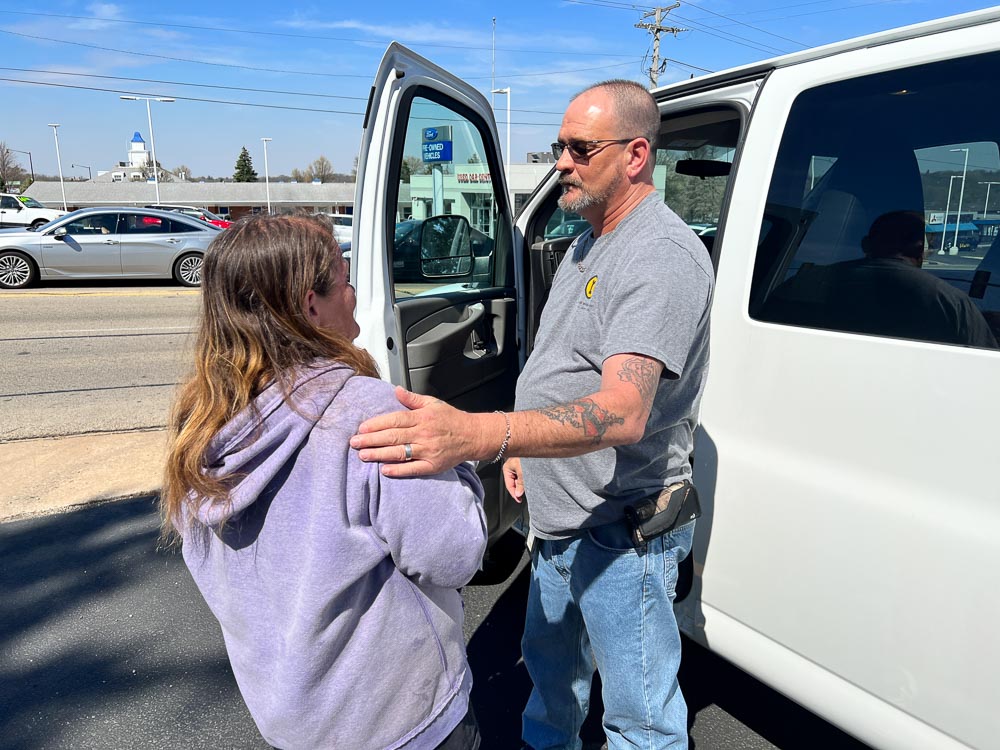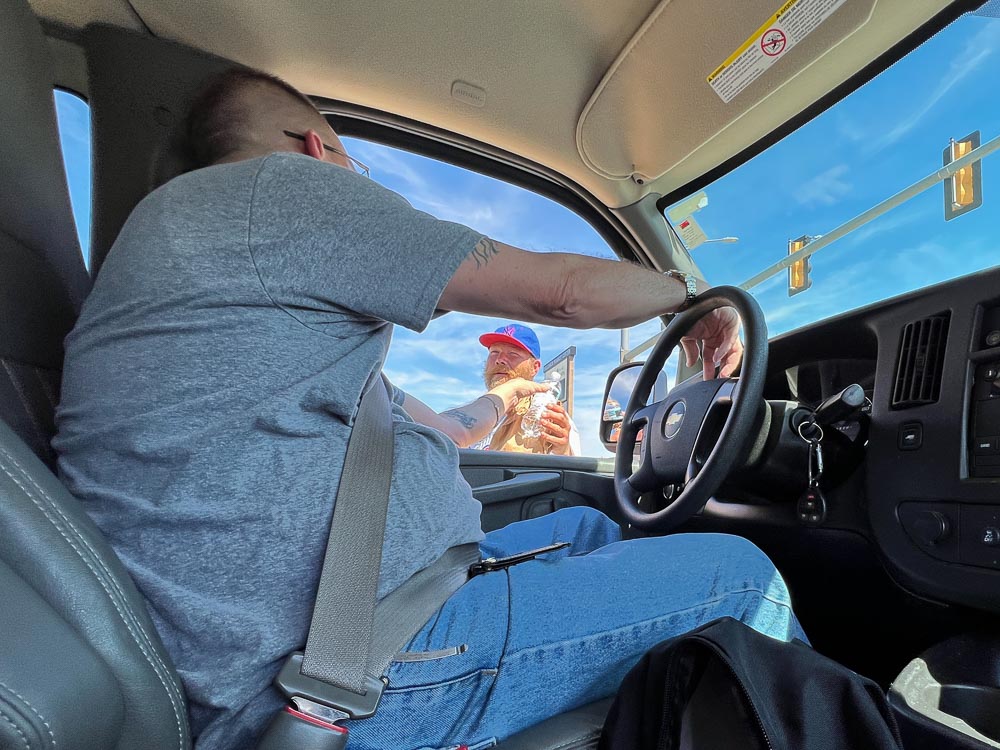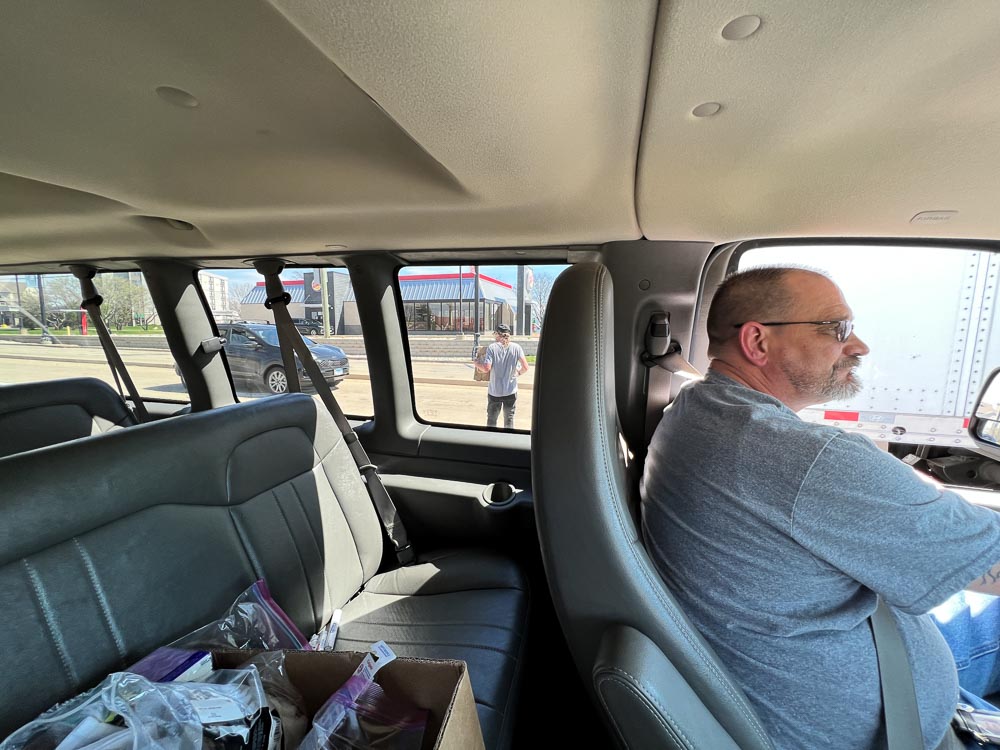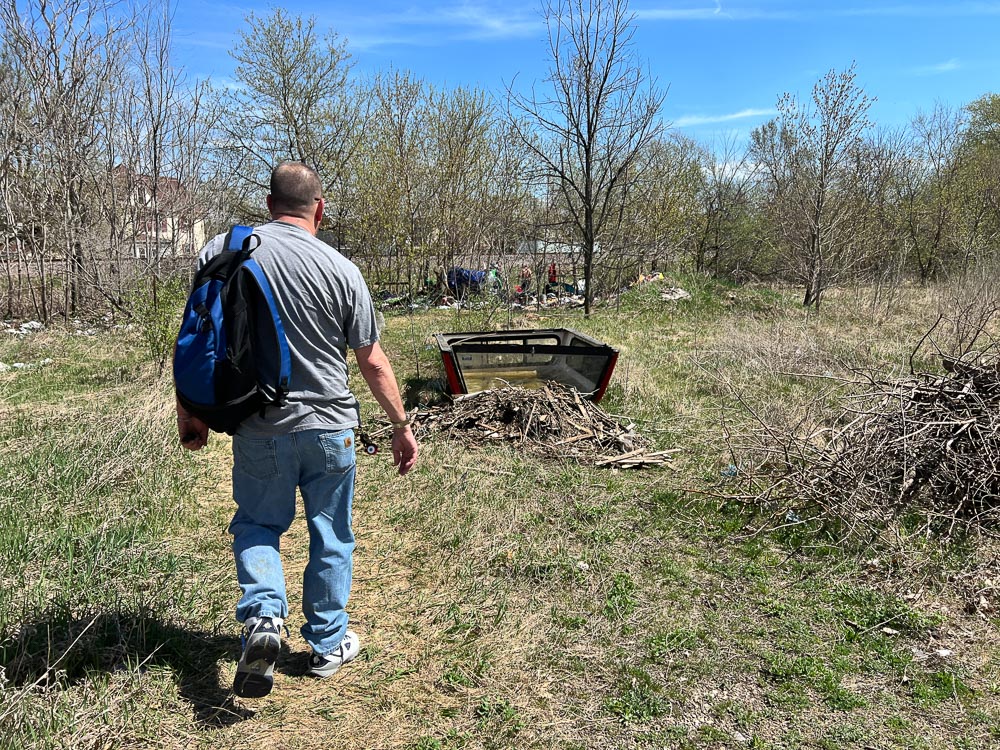Intersections
The Mission’s Outreach Services Meet Homeless People Where They Live

Fifteen feet from a metal sign that says “Panhandling is Not Safe,” a woman greets stopped cars with her own sign scrawled on cardboard:
Homeless
Anything Helps
Thank You
God Bless You
She’s working the busy corner of State and Alpine. Sometimes, another person or two independently works the other side of the intersection. Panhandling is most definitely dangerous, but it’s not illegal. At dozens of intersections around the Rockford area, drivers encounter the same dilemma. Is this person legit? Do I give them something? Do I avoid eye contact and hope the light turns green?
Three mornings each week, Mike Hedrick tries to give people something better. He’s the Mission’s Outreach Services Director, and he drives around town in the Mission’s white passenger van, stopping to chat and offer help as people are willing.
At State and Alpine, he pulls into a nearby parking lot, grabs a sack lunch and water and walks over to talk. “Annie” looks to be in her late 30s or 40s, wearing jeans and a purple hoodie. Along the cement wall at the corner, she’s staked out the spot with her jacket and backpack. She’s also got a large Coke from McDonald’s across the street, and a granola bar.
Mike knows her, but still greets her from a distance to avoid frightening her.
“Have you thought about coming to the Mission?” he asks.
She shakes her head.
“I have a cat.” (The Mission can’t take pets.)
Mike hands her a brown-bag lunch, a bottle of water, and noticing her sunburned face, a Chapstick.
“You really need to get off the street,” he says gently.
“I know.”
“Do you need some socks?”
She thinks about it for a moment.
“Yeah.”
“Come on, I’ve got some.”
They walk around the corner to the van, where Mike gives her not only new, white socks, but also a bag filled with travel-sized shampoo and other hygiene items.
He gives her a friendly pat on the shoulder and she walks away, toward the woods where she likely has a tent

The same people asking strangers for money aren’t always so receptive to lunch and water, especially if it’s from the Mission. Sometimes Mike will work around that by saying something like, “You know what? I really need to get rid of this stuff. You’d be helping me out by taking some.”
The people looking for daily heroin money tend to panhandle near high-traffic shopping areas, Mike says. They feel more desperate and don’t care about the stigma. Those, like Annie, who appear to still feel embarrassed about what they’re doing, still work busy intersections but not at the major retail centers.
Just as Mike says this, he spots “Richard” panhandling from the median at State and Bienterra. Richard went through the Mission’s Life Recovery program, and even graduated, but now is back on the streets and back on heroin. “He’s so far in his addiction right now that he can’t see a way out,” Mike says. “He doesn’t want to deal with the sick (withdrawal sickness during detox).”
It’s a sad reality of rescue work: For all of the victories and all the help available, some still choose the wrong way, even if it costs their life. Mike pulls into the turn lane and puts the window down, handing Richard a lunch and a bottle of water.
“When are you gonna be done with this, man?”
Richard looks up.
“Being sober sucks,” he says.
Traffic’s approaching. “You know you’re better than this,” Mike says as he eases onto the gas.
Driving away, Mike reflects on his own story. Fifteen years ago, on the morning of his 38th birthday, he woke up in his drug dealer’s van, where he had been living, And he thought: I can’t live this way anymore. He entered a recovery program that day, and has not used a drug or drink since. God changed his life and ultimately led him to being on staff at the Mission.
“I’m a very fortunate person,” he says. “I get to go back and reach out to the people that I once was. I used to be like Richard, standing on that corner.”

You’d think every person who panhandles went to the same sign-writing school. Start with a scrap from a cardboard box. Use black Sharpie marker, but don’t make it too neat. Mention that you’re hungry. Maybe that you’re a veteran. “God Bless” is a nice touch to stir guilt.
At Bell School and State, another guy, Jason, steps between two stopped trucks. Mike has talked with Jason before, He’s a convicted sex offender, so he’s not allowed to come to the Mission. It’s a hole in the system for which a good solution hasn’t yet been found. Mike hands him a lunch and Jason nods.
Further into town, Mike looks for telltale signs of a homeless encampment. Garbage, particularly food wrappers and bottles. Maybe a stray shopping cart. A vinyl tarp strung in trees is usually a makeshift tent.
Near 11th Street and 11th Avenue, a set of railroad tracks leads past a brambly brush area. Fifty yards from the tracks, a blue tarp drapes over some tree branches. Mike recognizes the occupant as “Daniel,” a guy he knew when both were in recovery at the Salvation Army. He doesn’t approach yet. Homeless people get robbed a lot, and you never know what someone might be ready to do.
Eye contact is made. Mike waves.
“Who are you?” Daniel shouts, even though he knows Mike.
“Rockford Rescue Mission,” Mike answers, holding up a lunch bag.
“Have a good day,” Denzel says, turning to walk back under the tarp.

That’s how it goes. Some discouragement, some hope. A whole lot of pain. And yet … a couple of days earlier, Mike had noticed a man in a wooded area near the East State Walmart. He gave him a sack lunch and invited him to the Mission.
“I have too much stuff,” the guy told him. But when Mike arrived back at the Mission a while later, the guy had already taken the bus and gotten there before him, receiving help in the Men’s Crisis Center.
“Too much stuff” is a common reason people say they don’t come. “Too many rules” is another, including the rule against cellphones in the day room. (That may sound harsh, but imagine the cacophony of music, videos and conversations, all playing at once, and the drama that could ensue.)
“I’m looking for ways we could store people’s stuff for them,” Mike says. “We want to remove barriers to why people aren’t coming to the Mission. He’s hoping next year’s budget includes bus passes, $1.50 each, that he can give people as a way to get to the Mission. Picking someone up and driving them there is not the best idea.
These van trips are far from the only thing Mike does as Outreach Director. Soon he hopes for volunteers to help serve as eyes and ears to encounter people who need help. But training will come first. He mentions a past volunteer who wanted to hug every homeless person she encountered.
“We want people to be safe. Over the years, people mean well, but they don’t realize what kind of risk they’re putting themselves in.”
No one ever said being the hands and feet of Jesus is an easy thing.
“The big thing is, don’t talk down to them,” Mike says. Talk as a friend. But don’t sugarcoat it, either. It’s a loving thing to tell someone, ‘You need to get in somewhere.’”
Story and photos: Jim Killam

The Mission offers printable “Get Help” cards that drivers can give to people who panhandle. The cards list the free services offered by the Mission.
Interested in volunteering with us? Check out this page and fill out our Volunteer Application.






